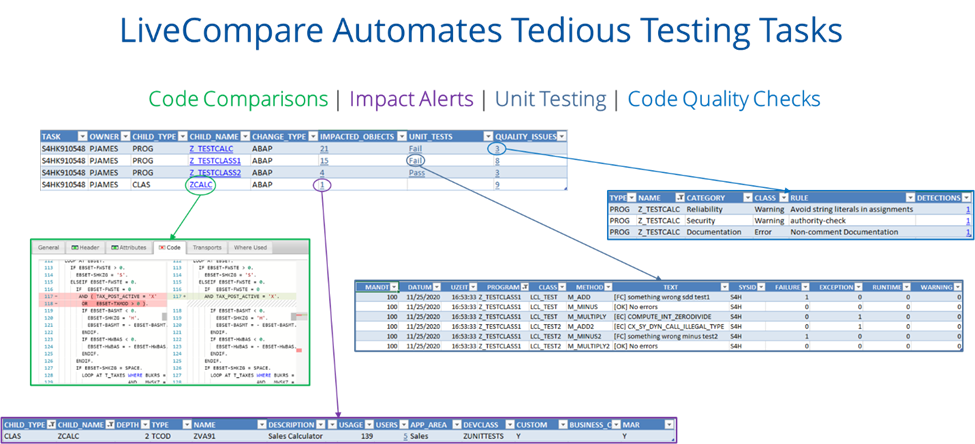
How testers and developers can finally get along
Experts explore why friction persists in even the most advanced...
Leaders need to answer the question, “How can my developers spend less time testing, and more time developing?” The answer? Automated unit testing.
Organizations everywhere know this truth—modernizing enterprise technologies like SAP is the key to surviving an increasingly digital business climate. Rapid software updates are crucial to ensuring organizations stay competitive and secure. It is imperative then that software release processes do not hinder innovation or expose companies to unnecessary productivity, security, financial, or other risks.
Changes to an organization’s SAP environment require lots of testing, which is often performed manually. Unit testing, which validates the smallest functional part of software, is often the first line of defense in the release cycle to catch defects. For developers, however, unit testing ends up being a “tedious, error-prone, and time-consuming” process, and takes time and resources away from fulfilling other business critical tasks.
CTOs and leaders are looking for way to answer the question, “How can my developers spend less time testing, and more time developing?”
The answer? Automated unit testing.
Think of software development like a group of people working together on a group paper or presentation. Some people may use spell check and be sure to edit any photos included. Others may simply put their ideas down on a slide or a page, without checking to make sure their material is formatted correctly. The quality of the overall project depends on the quality of each contribution, and will suffer if people follow different (or don’t have) standards of quality.
This is the same for developers working on SAP projects. Every ABAP developer has their own style and level of skill, and they may not all follow the same approaches to code quality—some may not be testing at all. Leaders need a way to make sure their team’s code meets minimum internal quality requirements, or else the entire project is at risk.
Automated ABAP unit testing can solve both the tedium of unit testing and the need to ensure consistent quality across development teams. The alternative is to keep putting business at risk due to issues with custom ABAP code.
Some ABAP testing tools are restricted to certain SAP environments, only offer limited integrations, or can’t perform tests in your native SAP environment. Others may also have small levels of automation, but don’t completely eliminate manual work. And to top it all off, some tools can be difficult to deploy and are not user friendly, further hindering both quality and speed.
Tricentis LiveCompare is not your average change intelligence tool. It provides SAP teams with AI-powered analytics and insights that significantly reduce the risk, time, and cost of delivering and supporting changes to SAP systems. As a part of these capabilities, LiveCompare can run SAP’s own ABAP unit tests and performs a series of validations against ABAP quality rules.
LiveCompare includes Continuous Developer Impact Analysis (DIA), which automates a variety of quality checks for developers. Whenever a developer submits submits updated ABAP code, LiveCompare gives them these insights within 30 minutes:
The following diagram shows sample DIA results. These include links to code comparisons, impact alerts, unit test results, and code quality checks.
 By automating these tasks across all your development teams, LiveCompare improves the quality of your custom code across the board. It identifies and resolves defects before developer changes reach QA, where they are 10 times more expensive to fix, or production where they are 30 times more expensive to resolve. That figure does not include the potential disruption and downtime defects may cause.The result? Developer Impact Analysis from LiveCompare speeds up SAP release times, while increasing quality and lowering risk.
By automating these tasks across all your development teams, LiveCompare improves the quality of your custom code across the board. It identifies and resolves defects before developer changes reach QA, where they are 10 times more expensive to fix, or production where they are 30 times more expensive to resolve. That figure does not include the potential disruption and downtime defects may cause.The result? Developer Impact Analysis from LiveCompare speeds up SAP release times, while increasing quality and lowering risk.
You can check out Developer Impact Analysis and all LiveCompare’s other features for yourself by scheduling a demo with one of our experts.

Experts explore why friction persists in even the most advanced...

Explore how SAP users can manage new technologies, like AI agents...

Introducing Tricentis SeaLights for ABAP, a powerful Change Impact...

Explore how Tricentis and its best-in-class test automation...

See how we’re pushing the boundaries of AI-driven performance...

Join leaders from HUGO BOSS and Tricentis as they share how to...